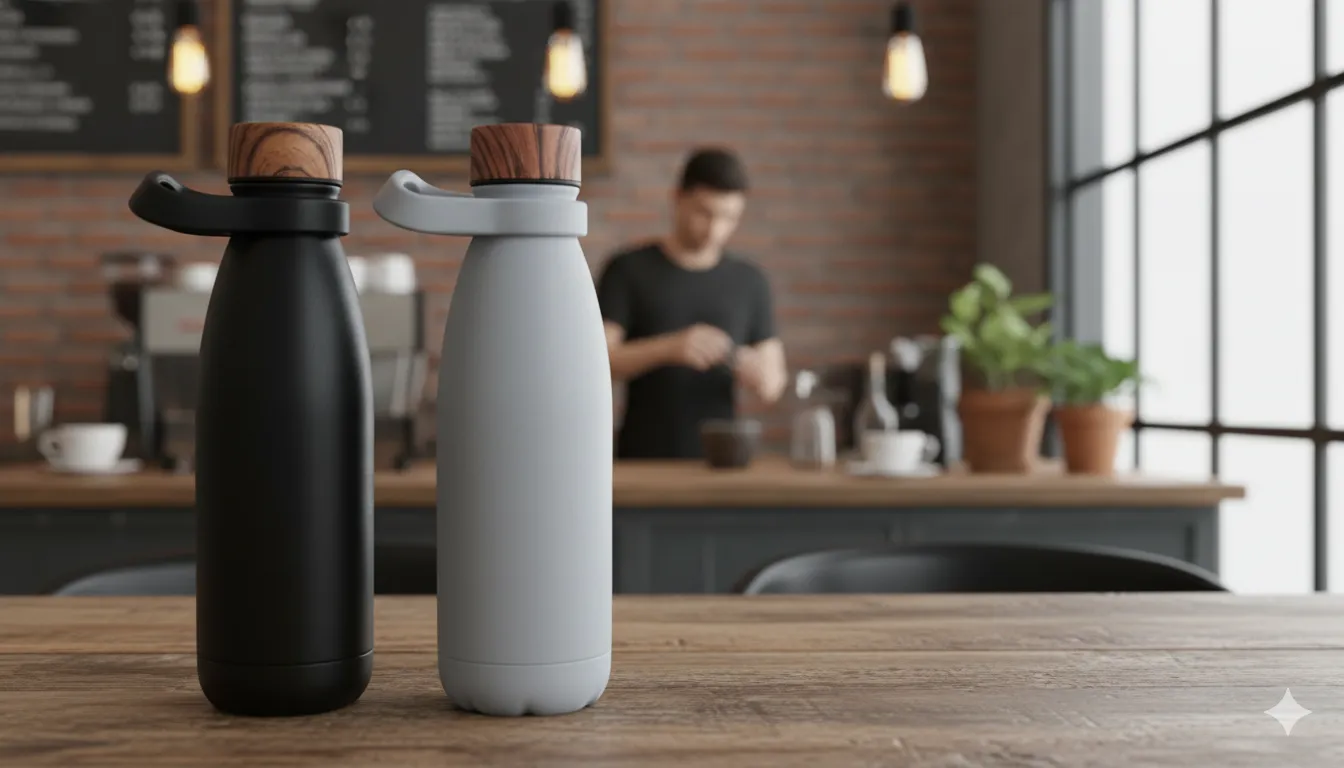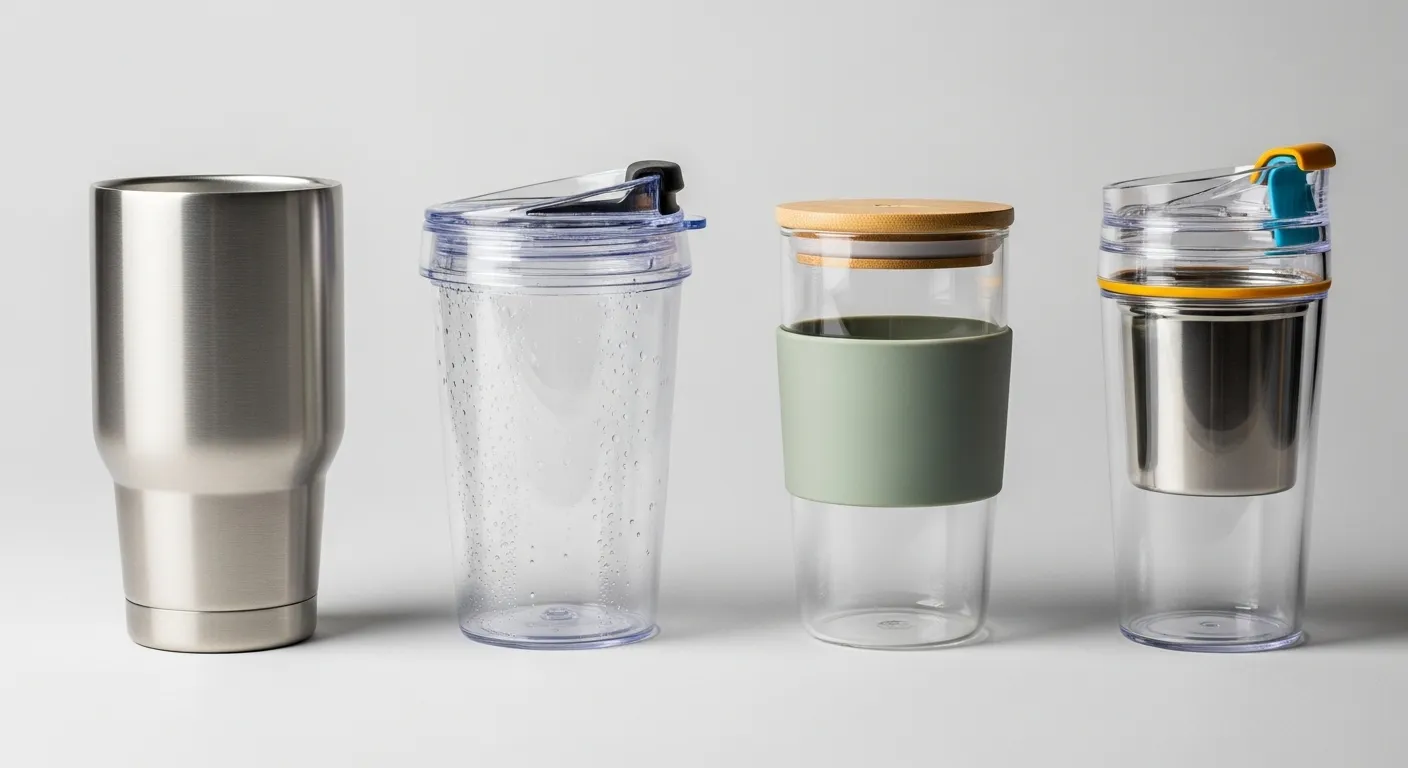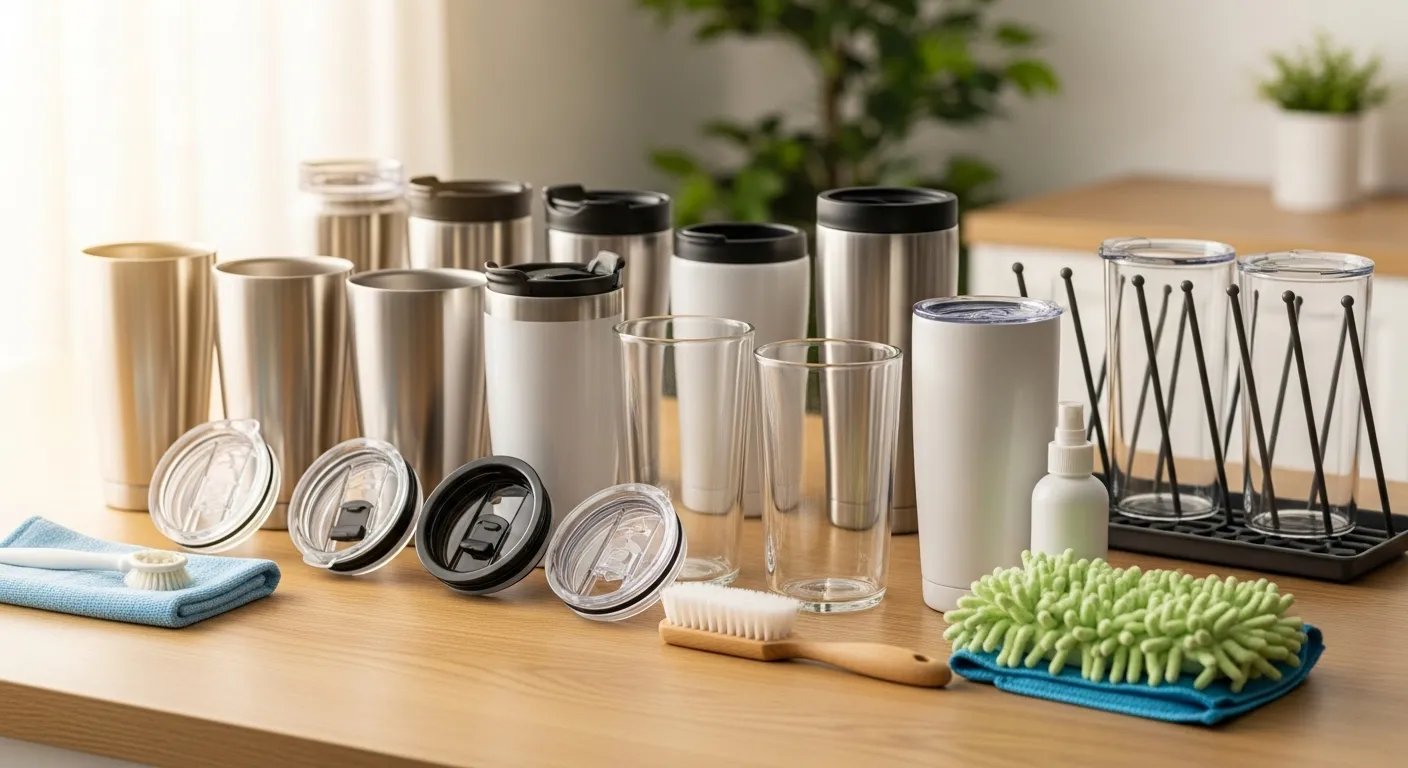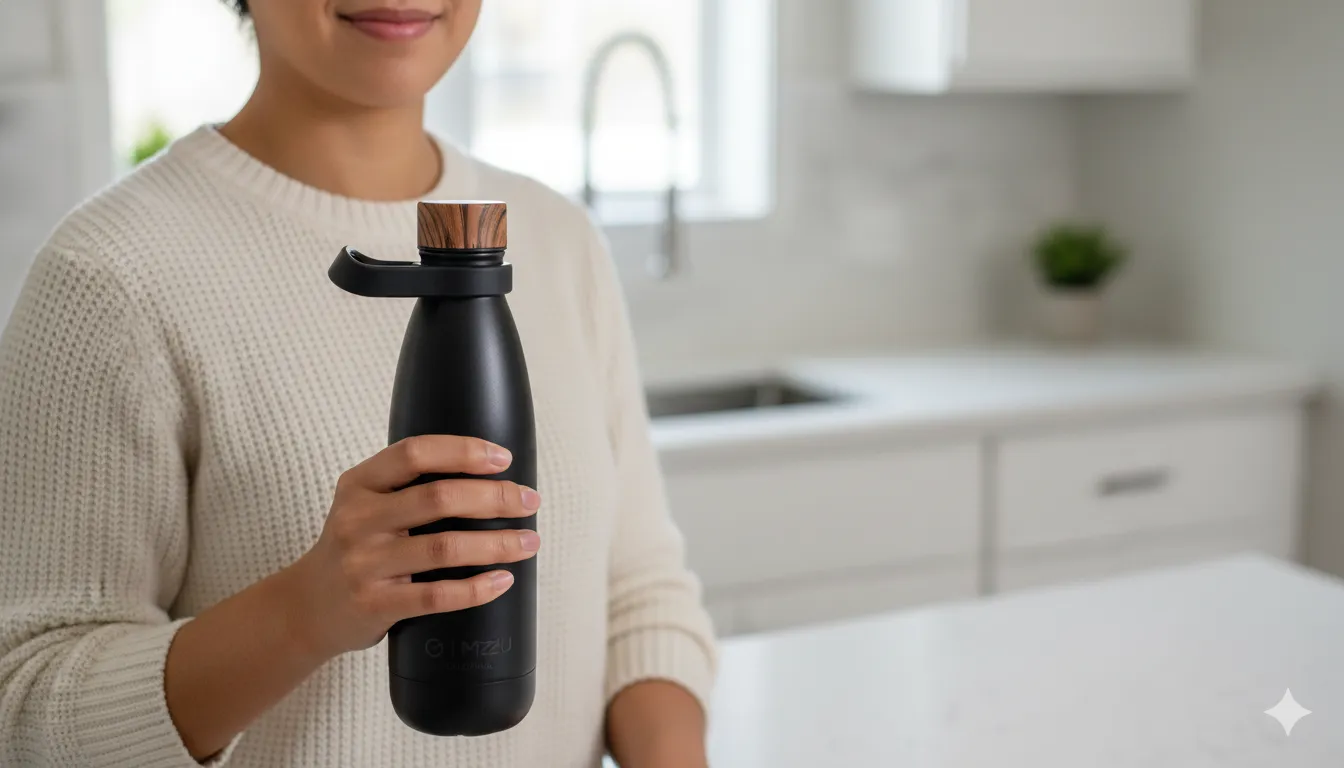
Blog
Tumbler types: Ultimate Guide to Materials Explained

The Essential Guide to Tumbler Types: Find Your Perfect Sip
So, you’re looking for the perfect cup to keep your drinks just right, whether hot or cold, at home or on the go. Understanding the different tumbler types out there is the first step to making a smart choice. It’s more than just a container; it’s about matching your lifestyle to your drinkware needs.
When we talk about tumbler types, we’re really diving into a world of variety. Each type serves a slightly different purpose, designed with specific users and beverages in mind. From your morning coffee to your post-gym hydration, there’s a tumbler for nearly every occasion.
Let’s look at some common categories you’ll encounter:
- Travel Mugs: These are your go-to for commutes, often featuring leak-proof lids and a comfortable grip for car cup holders. They are frequently insulated tumblers, perfect for keeping coffee hot or iced tea cold.
- Everyday Tumblers: Ideal for home or office use, these are often designed for cold beverages and frequently come with a straw. Many options are simple plastic tumblers or basic glass designs.
- Water Bottles: While not always strictly called tumblers, these are essential for hydration and come in various forms, often as durable stainless steel tumblers or sturdy plastics. They prioritize easy refilling and portability.
- Insulated Tumblers: This is a broad category focused purely on temperature retention, essential for both hot and cold drinks over extended periods. Many premium beverage containers fall under this umbrella.
Choosing the right one means considering what you’ll drink, where you’ll take it, and how important temperature control is to you. By exploring these diverse tumbler types, you’re well on your way to finding your ideal beverage companion.
Unveiling the Core Materials: Stainless Steel, Plastic, Glass, and Beyond

When picking out your perfect sip companion, the material it’s made from is super important. It affects everything from how long your drink stays hot or cold to its overall durability. Understanding the different materials is key to navigating the world of various tumbler types.
First up is stainless steel, a true powerhouse. Many of the best insulated tumblers and travel mugs are crafted from this. It’s fantastic at keeping temperatures steady.
Stainless steel is also incredibly durable and won’t usually impart any weird flavors to your drink. The downside? They can be a bit heavier and often come with a higher price tag. But for long-lasting performance, stainless steel tumblers are tough to beat.
Next, we have plastic tumblers. These are super lightweight and usually very affordable. You’ll find a huge range of colors and designs, especially in everyday water bottles and basic tumblers.
However, plastic might not hold temperatures as well as stainless steel options. Some people also worry about chemicals, though many modern plastics are BPA-free. They are generally less durable and can sometimes stain or retain odors.
Then there’s glass, known for its clean taste. Your beverage will always taste pure, with no metallic or plastic notes. Glass tumblers often look very stylish and simple.
The main drawback is fragility; they can break easily if dropped. Glass also offers almost no insulation, so your hot drinks will cool quickly and cold ones will warm up fast.
Beyond these main contenders, you might find ceramic or even bamboo-fiber options entering the market. These offer unique aesthetics and different feels. Ultimately, the material chosen defines the core purpose and everyday experience of different tumbler types, making your choice truly personal.
Beyond Basic: Exploring Insulated vs. Non-Insulated Tumblers for Optimal Temperature
Past materials, a tumbler’s temperature handling is vital. The distinction between insulated tumblers and non-insulated versions is crucial. This is a key factor among various tumbler types.
Insulated tumblers, often popular travel mugs, use a vacuum seal. Two walls with an airless gap stop heat transfer effectively. This keeps your coffee hot or iced tea cold for many hours, ideal for all-day use.
Their main advantage is incredible temperature retention. For drinks needing to stay hot or cold, insulated options like stainless steel tumblers are your best bet.
Non-insulated tumbler types are simpler. They’re usually a single wall, like basic glass or simple plastic tumblers. No special technology blocks heat transfer here.
These are ideal for quick drinks where temperature isn’t critical. Lighter, more affordable, and including many everyday water bottles, they’re perfect for short-term sips.
Your choice depends on priorities. For optimal temperature, pick an insulated tumbler. For convenience and casual sips, a non-insulated one works well. Understanding these tumbler types helps you find your perfect fit.
Choosing Your Ideal Tumbler: A Practical Guide for Every Lifestyle and Beverage
With many tumbler options, choosing the right one can feel tricky. But it’s simple: match your habits and drinks to the perfect cup. Let’s find your ideal companion.
- For the Commuter & Traveler: Always on the move? A reliable travel mug or robust insulated tumbler is essential. Seek leak-proof lids and a cup-holder friendly design. Stainless steel tumblers excel for durability and temperature retention on journeys.
- For the Gym-Goer & Outdoor Enthusiast: Hydration is vital during workouts or adventures. A sturdy water bottle, often a single-wall stainless steel tumbler or tough plastic tumbler, is ideal. Easy cleaning and carrying are big pluses. Consider a wide mouth for ice!
- For the Office & Home: When settled, capacity and style become priorities. An elegant glass tumbler or large insulated tumbler keeps drinks just right, minimizing refills. Many favor sizable stainless steel tumblers for desk-side sipping.
Ultimately, selecting from various tumbler types depends on your unique needs. Consider your beverage, location, and required temperature retention. This guide simplifies choosing the best fit for your lifestyle.
Top 7 Features That Make a Tumbler a Must-Have: Lids, Straws, and Ergonomics
Beyond material, the right features truly matter for your daily use. These details help you pick from the many tumbler types out there.
Here are seven key features to consider:
- Lid Design: A secure, leak-proof lid is crucial to prevent spills for any tumbler types. Look for flip-tops or slider lids, especially for travel mugs.
- Straw Compatibility: Many prefer sipping with a straw. Some lids accommodate reusable straws, ideal for cold beverages.
- Ergonomics & Grip: A comfortable grip that fits your hand and car cup holder is vital. This enhances usability across all tumbler types.
- Insulation Performance: Quality insulated tumblers keep drinks hot or cold for extended periods. This is a real game-changer.
- Material Durability: A must-have tumbler should be tough. Sturdy stainless steel tumblers and robust plastic tumblers withstand daily use.
- Ease of Cleaning: Simple designs and wide mouths make washing easier. Dishwasher-safe components are a huge convenience.
- Appropriate Capacity: Choose a size that suits your needs. Whether a small coffee cup or a large water bottle, the right capacity is essential.
Smart Care & Maintenance: Extend the Life of Your Favorite Tumblers

Keeping your favorite tumblers clean isn’t just about hygiene; it’s about making them last. Proper care ensures your drinks always taste fresh. Let’s explore how to maintain different tumbler types effectively.
General Cleaning Best Practices
- Rinse Immediately: A quick rinse after use prevents residue from drying. This simple step saves effort.
- Hand Wash vs. Dishwasher: Always check manufacturer instructions. While many stainless steel tumblers and plastic tumblers are dishwasher safe, hand washing preserves seals on insulated tumblers. Use mild soap and a soft brush.
Material-Specific Tips
- Stainless Steel: For stubborn stains, a baking soda paste works well. Always dry thoroughly to prevent water spots.
- Plastic: Plastic can absorb odors. A vinegar rinse helps eliminate smells. Avoid excessively hot water if not specified heat-resistant.
Lids, Seals & Storage
Always remove lids and gaskets for thorough cleaning to prevent mold. Air dry all components of your tumbler types completely, ideally upside down. Storing them lid-off prevents stale odors, ensuring they’re ready for next use.
Beyond the Buzz: Uncovering Unique & Niche Tumbler Innovations You Need to Know

Beyond common choices, drinking vessels offer constant innovation. Manufacturers continually find new ways to make hydration more convenient. Let’s explore some truly unique and niche tumbler types.
Infuser Tumblers: Flavor On The Go
Love flavored water or loose-leaf tea? Some come with built-in infusers. Add fruit, herbs, or tea directly for a custom, refreshing taste.
Smart Tumblers: Hydration Trackers
Yes, your water bottles can be smart! These high-tech options connect to an app. They track hydration, remind you to drink, or display beverage temperature.
Collapsible Designs: Space Savers
For travelers needing space, collapsible insulated tumblers are game-changers. Made from durable silicone, they fold flat when empty, making packing easy.
Self-Stirring Tumblers: Effortless Mixing
Imagine a travel mug that stirs your coffee or protein shake. A small motor at the bottom mixes your drink perfectly. No more lumpy shakes!
Tech-Integrated Tumblers
Some innovative tumbler types include built-in Bluetooth speakers or LED lights. Others offer purification systems, pushing vessel boundaries.
From eco-friendly materials to complex electronics, these niche innovations highlight endless possibilities. A perfect new tumbler type awaits discovery!
Frequently Asked Questions
Which tumbler material and design are most effective for maintaining beverage temperature over long periods?
For superior temperature retention, vacuum-insulated stainless steel tumblers are unequivocally the best. Their double-wall construction with a vacuum layer minimizes heat transfer through conduction and convection, keeping drinks hot for 6-12 hours and cold for 12-24 hours. Paired with a well-sealed, insulated lid, this design traps thermal energy most efficiently, making them ideal for all-day use.
Why might my insulated tumbler stop keeping drinks hot or cold as effectively as it once did?
The most common reason for a decline in temperature retention is a compromised vacuum seal. If the vacuum layer between the inner and outer walls is breached (e.g., due to a drop, dent, or manufacturing defect), air can enter, allowing heat to transfer much more readily. Less often, a damaged or improperly sealed lid, or residue buildup around the seal, can also lead to significant temperature loss. Inspect for external dents, rattling sounds, or noticeable condensation on the outer wall (when it should remain dry) as indicators of a compromised vacuum.
Are there specific tumbler types or features recommended for preventing spills and leaks, especially when on the go?
Absolutely. For maximum leak prevention, look for tumblers with screw-on lids that feature a tight-fitting gasket or silicone seal. Types with a secure, locking mechanism for the drinking spout (e.g., flip-top with an additional lock, or a push-button with a reliable seal) are highly recommended. Avoid simple press-fit lids if spill-proofing is a primary concern, as they are prone to accidental dislodging or minor drips when jostled.
How should I properly clean different tumbler materials to avoid odors, stains, or bacterial growth?
While specific care varies, general best practices include immediate rinsing after each use. For stainless steel and most plastics, hand washing with warm, soapy water and a bottle brush is recommended, paying close attention to lid components, gaskets, and seals where residue can accumulate. For lingering odors (common with coffee or protein shakes), a mixture of baking soda and warm water, or a specialized cleaning tablet, can be very effective. Always ensure tumblers are thoroughly air-dried before storage to prevent mold or mildew, and avoid harsh abrasive cleaners that can damage material surfaces or coatings.
